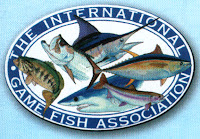The most anticipated book of the sport fishing world is on its way! The 2012 edition of the IGFA's annual World Record Game Fishes book is due in mailboxes in early January and contains articles for the technique-minded, nostalgic, and record-seeking angler alike. This year's reference book offers new ideas for spinning tackle and big game fly methods, destination essays, a bit from the bosses of bass, a conservation update and of course - the revered review of records.
 First, Alistair McGlashan talks nuts and bolts in Big Game Tactics with Spinning Tackle. Alongside Jerry Gibbs' No-Fail Billfish on Fly: Heavy Lifting Techniques, this year's publication will keep big game fans busy no matter their gear. The IGFA also takes an in-depth look at the research being done - and the need for more - to protect one of the most prized big game species, marlin, in IGFA Great Marlin Race: The Race is On!
First, Alistair McGlashan talks nuts and bolts in Big Game Tactics with Spinning Tackle. Alongside Jerry Gibbs' No-Fail Billfish on Fly: Heavy Lifting Techniques, this year's publication will keep big game fans busy no matter their gear. The IGFA also takes an in-depth look at the research being done - and the need for more - to protect one of the most prized big game species, marlin, in IGFA Great Marlin Race: The Race is On!But never fear, freshwater enthusiasts, this year's book offers plenty more than bluewater pieces. Pat Ford's exotic Chilean Patagonia: Puma Lodge, Yelcho Watershed offers a beautiful photo essay on a remote and world-class South American fishery. In Bass Brothers: Faces of the IGFA Hall of Fame, IGFA Hall of Fame honoree Mark Sosin interviews some of the biggest names in bass fishing history, including Bill Dance, Jimmy Houston, Roland Martin, Johnny Morris and Ray Scott.
For those who live for the adventure of fishing in new locales, Matt Harris' Five Places to Fish Before You Die chronicles some of the most breath-taking destinations on the planet, along with essays describing his catches in each. IGFA Expedition: Costa Rica - The Zancudo Lodge focuses on one particular destination with more than 70 world records to its name, and to which the IGFA will be trekking later in 2012.
But finally, for die hard anglers of every persuasion, the back half of World Record Game Fishes is devoted completely to records. The top ten men, women, juniors, species, tackle and more are all covered, as well as every slam achieved and every record standing at the time of publication. This year's record printing will see the first time the striped bass record has been updated in 29 years and the debut of the massive 120 kg (262 lb 8 oz) convict grouper caught in Japan. Along with hundreds of other catches, these are what make the World Record Game Fishes book so coveted - it's all about the fishing.
www.igfa.org





























